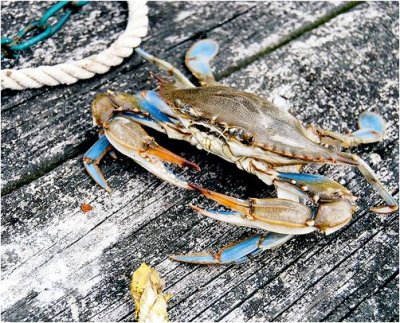
Blue Crab (Photo: Md. Dept. of Natural Resources)
ANNAPOLIS (May 1, 2014)—The Maryland Department of Natural Resources today released the 2014 Blue Crab Winter Dredge Survey results, which showed the abundance of spawning-age females was 69 million, declining just below the minimum safe level of 70 million.
While the crabbing harvest remained at a safe level for the sixth consecutive year, and juvenile crabs increased 78 percent from 2013’s record low, the total abundance of crabs — which include juveniles, and adult males and females ? has returned to pre-2008 levels of approximately 300 million.
The results illustrate the inherent variability of the Blue Crab population and the ever-present complexities of managing this dynamic fishery. There are a suite of environmental factors that could be contributing to the low crab abundance, including the unusually cold winter, coastal currents, weather patterns and natural predators.
The long cold winter appears to be one cause of the low abundance level. Low water temperatures resulted in one of the worst cold-kill events since the start of the survey in 1990, causing the death of an estimated 28 percent of adult crabs in Maryland.
This decline in spawning age females will be the biggest factor in determining new management actions by Maryland, Virginia and the Potomac River Fisheries Commission to increase reproductive potential in 2014 and 2015.
“Since crab harvests remained at safe levels, our scientists believe an array of environmental factors impacted Blue Crab abundance,” said DNR Secretary Joe Gill. “With the number of spawning age crabs low, and juveniles at pre-2008 levels for two years running, we will be working with our partners and stakeholders to develop adaptive management strategies that will protect the next generation of spawners.”
Maryland, Virginia and the Potomac River Fisheries Commission remain committed to collaborating on a two-pronged management approach. The first action will be to protect the adult females that will be spawning this summer. The second will be designed to protect the current population of juvenile females through next spring, to build up the female population that will spawn in 2015. The three jurisdictions will be consulting further with scientists and stakeholders to identify the specific actions to be implemented.
“Even though our 2008 conservation measures were designed to allow for naturally occurring fluctuations in Crabs, these results are not what we had hoped to see,” said DNR Fisheries Director Tom O’Connell. “What is most important here is that the structure we put into place to cooperatively manage this fishery is strong, and that we continue to work with our partners and stakeholders to initiate a new stock assessment that could help evaluate our current management framework.”
“This is disappointing news. This is the population’s response to the Chesapeake Bay’s constantly changing ecosystem,” said Virginia Marine Resources Commissioner John Bull. “We are now in a position to focus on the depleted adult females and move forward to increase protection of the next generation.”
DNR and the Virginia Institute of Marine Science have conducted the primary assessment of the Bay’s Blue Crab population annually since 1990. The survey employs crab dredges to sample Blue Crabs at 1,500 sites throughout the Chesapeake Bay from December through March. Sampling during winter when Blue Crabs are usually buried in the mud and stationary, allows scientists to develop, with good precision, estimates of the number of Crabs present in the Bay.
The Chesapeake Bay Stock Assessment Committee, supported by NOAA’s Chesapeake Bay Office, is reviewing the data; their 2014 Blue Crab Advisory Report is expected to be released in early summer.
Since 2011, Governor O’Malley and the Maryland General Assembly have passed legislation that increased enforcement authority and penalties for egregious violations of striped bass, oyster and blue crab regulations and important measures to increase efficiency, flexibility and accountability in Maryland’s commercial fishing license system.
In 2008, NOAA’s National Marine Fisheries Service responded to Governor O’Malley’s request for disaster assistance funding for watermen impacted by the declining Blue Crab population. With support from Senator Barbara Mikulski and Maryland’s Congressional Delegation, DNR received $15 million to assist management efforts and mitigate the impacts from the Blue Crab fishery disaster. In 2009 and 2010, Governor O’Malley and the Maryland General Assembly also directed $6 million in capital funding toward these efforts. In further support of the industry, last year DNR launched the True Blue labeling and promotion program that will let restaurant-goers know whether their seafood dishes use meat from Maryland blue crabs or less expensive crabmeat from abroad.
Complete survey results are available at http://dnr.maryland.gov/fisheries/crab/dredge.asp.
Source: Maryland Department of Natural Resources


